On the Path to the NGSS
By Diane Johnson
Posted on 2019-05-22
As several reports have shown, it is critical for teachers to understand instructional strategies that are consistent with the NGSS vision, as well as to have the skills to implement them in their classrooms. I had the privilege of working with two early-career eighth-grade teachers at South Warren Middle School in Bowling Green, Kentucky, as part of an NSTA coaching pilot program. A lesson I learned from this opportunity was that there are many paths toward realizing the vision of the NGSS in the classroom, but, as the ancient Latin adage says, experientia docet (“experience teaches”).
Find Your Starting Place
Both teachers were receptive to trying different instructional strategies but found that understanding these strategies and designing instruction was one thing, while implementing them was something totally different. We were focused on working toward the performance expectation, MS-LS3-1. (Develop and use a model to describe why structural changes to genes (mutations) located on chromosomes may affect proteins and may result in harmful, beneficial, or neutral effects to the structure and function of the organism.)
To clarify our understanding of the disciplinary core idea, we consulted the Framework, Evidence Statements, and chapter 8 of the NSTA Press book, Disciplinary Core Ideas: Reshaping Teaching. In making sense of the standard, questions arose, such as How do we help students figure this out? Shouldn’t they know about the different types of mutations first? Isn’t this too abstract for middle school students?
As a fan of the Argument-Driven Inquiry (ADI) materials, I knew they included a lab that addressed the standard, which I shared and offered to team-teach. Since each teacher was at a different point in their district’s learning sequence for this standard, Kaylee Okenye agreed to try Lab 15, Mutations in Genes: How Do Different Types of Mutations in Genes Affect the Function of an Organism? (Enderle, 2015, pp. 248–262), with her students. Lab 15 uses a free simulation from the Concord Consortium (available at http://concord.org/stem-resources/mutations) that allows students to test DNA base substitutions, deletions, and insertions and gauge the impact by observing changes in the amino acid sequence and the protein’s structure.
Find Your Collaborator/Sounding Board/Comfort Zone
Okenye has a strong background in biology and would be at ease fielding questions from the students about the content as they arose. I could provide the support for helping students use the appropriate practices and crosscutting concepts, at the element level, as they worked to figure out the effects of gene mutations on protein structure. Having used the ADI materials many times, I could also suggest scaffolds based on Okenye’s knowledge of her students. Table 1 provides a summary of the experiences we designed.
Table 1. Summary of Lesson and Scaffolds Used
| Day | What Students Did | Scaffolds Used |
| 1 |
|
|
| 2 |
|
|
| 3 |
|
|
| 4 |
|
|
Recognize Productive Struggle
The group proposal served as an important formative assessment for us. Groups could not begin to carry out their investigation until we signed off on their proposal. This allowed us to uncover student thinking using probing questions about content, practices, and crosscutting concepts.
Although students knew textbook definitions for independent and dependent variables and controls, they struggled to identify them for this investigation or to use them to design a method for recording their data. Because every group had difficulty with this, we called everyone together and provided a way to think about organizing data, which also helps to sort independent from dependent variables. Table 2 is an example of one group’s data table after this support.
Table 2:
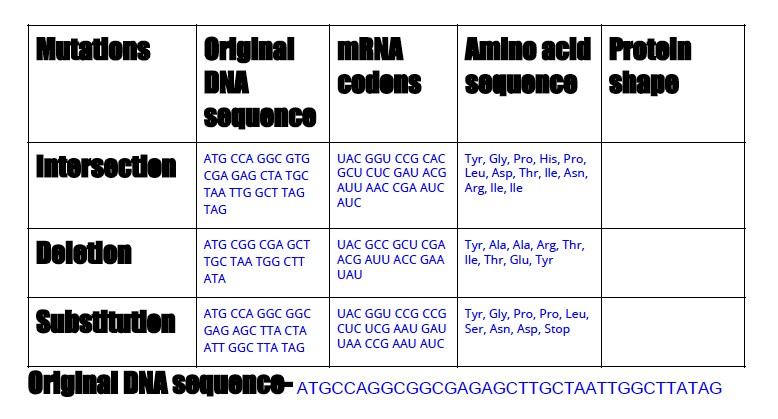
With screen shots of the protein resulting from different mutations:
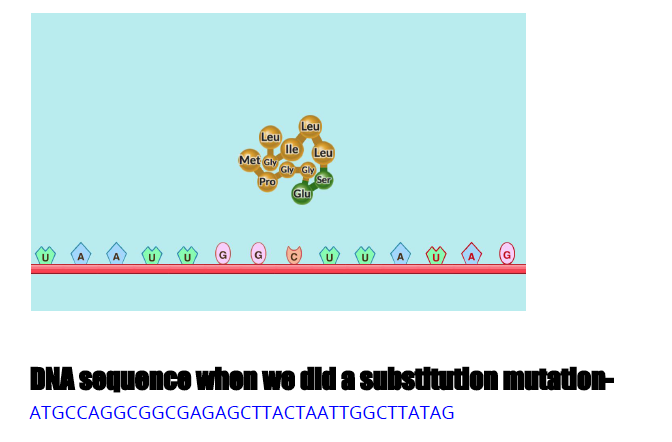
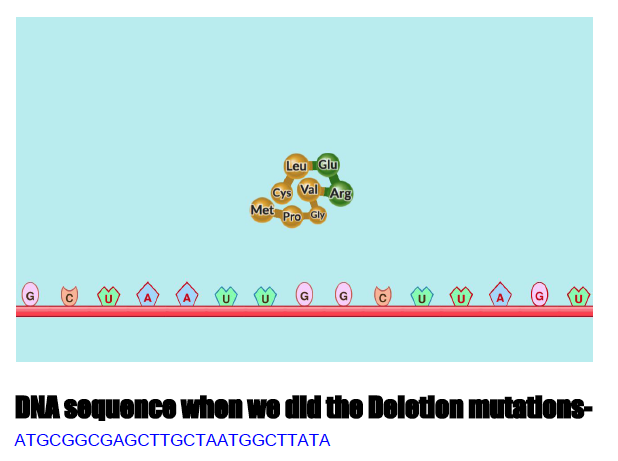
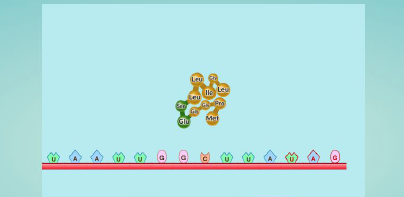

Examination of the exit slips revealed that the majority of students’ mental models held the common misconceptions that all mutations are harmful and that deletion of a base was responsible for the most harmful changes. Their responses reinforced the need to provide scaffolding for using evidence to support a claim and that core ideas are needed to tie the evidence to their claim (reasoning). This is something the argumentation session would target.
Students’ questions spoke volumes about not only their comfort level with this shift in instruction but also their growing understanding. Questions ranged from, Is this what you want on the data table? and How many times do we need to run the simulation? to Why doesn’t the protein structure change each time there is a mutation? and What causes a mutation to happen?
Okenye had several concerns. She said she felt that the first day was a “train wreck” and observed “Students were lost at first. They weren’t making connections, didn’t know how to design an experiment, and didn’t know how to set up a data table.” In hindsight, she thought we should have “provided more scaffolding” because it was the first time students had planned and carried out an investigation.
She noted that “in the past, students had to memorize the steps to the scientific method and learn vocabulary, but they didn’t get any practice in designing an experiment. Test prep has required cramming content and left no time for experimentation.” To further add to the confusion, “groups had varied data sets. One group would say that an insertion was more harmful than a deletion, because it changed the protein length. Another group would say that their data didn’t show that.”
From my perspective, the team-teaching and use of quality instructional material was very successful. Okenye was implementing a three-dimensional lesson at the element level. We were working on classroom discourse, and students were being challenged cognitively.
It is often uncomfortable to embrace the productive struggle that is necessary for learning. Sometimes, it is a fine line between struggle and frustration. But I wouldn’t describe day one as a “train wreck.” I would describe it as a classic example of productive struggle. When we were debriefing, Okenye stated that, “If students were asked to plan another experiment and to design a data table, they would be able to do it.”
Through argumentation, students had a wealth of evidence to support a claim that “…structural changes to genes (mutations) located on chromosomes may affect proteins and may result in harmful, beneficial, or neutral effects to the structure and function of the organism,” because of the varied data sets each group had. To make sense of this rich data, they needed to understand and apply the underlying core ideas. Of course, this is very different from conducting a cookie-cutter, verification lab in which success is determined by reaching the pre-drawn conclusion.
Take-Home Message
When I think about what professional learning experiences are required to help teachers implement the NGSS, the Beatles’ song, “The Long and Winding Road” often plays in my head. There are many paths for teachers to take, but experiencing instructional strategies that are consistent with the NGSS with your students may straighten some of those curves. Experientia docet.
Please share your experiences and/or comments about your journey implementing NGSS. Feedback and suggestions are greatly appreciated, too!
References
Duncan, R., J. Krajcik, and A. Ravit eds. 2016. Disciplinary Core Ideas: Reshaping Teaching and Learning. Arlington, VA: National Science Teachers Association.
Enderle, P. (2015). Argument-driven inquiry in life science: Lab investigations for grades 6-8. Arlington, VA: National Science Teachers Association.
National Academies of Science, Engineering, and Medicine. 2015. Science teachers’ learning: Enhancing opportunities, creating supportive contexts. Washington, DC: The National Academies Press. Also available online at https://doi.org/10.17226/21836.
National Research Council. 2012. A Framework for K–12 Science Education: Practices, Crosscutting Concepts, and Core Ideas. Washington, DC: National Academies Press. Also available online at https://doi.org/10.17226/13165.
National Research Council. 2015. Guide to Implementing the Next Generation Science Standards. Washington, DC: National Academies Press. Also available online at https://doi.org/10.17226/18802.
NGSS Lead States. 2013. Next Generation Science Standards: For States, By States (insert specific section title(s) being used if not referring to entirety of the NGSS). Retrieved from http://www.nextgenscience.org/.
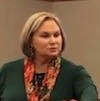 Diane Johnson is a Master Teacher for the MSUTeach program at Morehead State University and a Regional Teacher Partner for PIMSER (Partnership Institute for Math and Science Education Reform) at Eastern Kentucky University. Johnson taught high school science for 25 years and served as an instructional supervisor for five years in Lewis County, Kentucky. Additionally, she is a member of Achieve, Inc’s Peer Review Panel and one of NSTA’s Professional Learning Facilitators. Johnson holds a bachelor’s and a master’s degree in biology, and a second master’s in supervision, and is ABD in science education. Follow me at @MDHJohnson and jdiane72@gmail.com
Diane Johnson is a Master Teacher for the MSUTeach program at Morehead State University and a Regional Teacher Partner for PIMSER (Partnership Institute for Math and Science Education Reform) at Eastern Kentucky University. Johnson taught high school science for 25 years and served as an instructional supervisor for five years in Lewis County, Kentucky. Additionally, she is a member of Achieve, Inc’s Peer Review Panel and one of NSTA’s Professional Learning Facilitators. Johnson holds a bachelor’s and a master’s degree in biology, and a second master’s in supervision, and is ABD in science education. Follow me at @MDHJohnson and jdiane72@gmail.com
Note: This article is featured in the May issue of Next Gen Navigator, a monthly e-newsletter from NSTA delivering information, insights, resources, and professional learning opportunities for science educators by science educators on the Next Generation Science Standards and three-dimensional instruction. Click here to sign up to receive the Navigator every month.
Visit NSTA’s NGSS@NSTA Hub for hundreds of vetted classroom resources, professional learning opportunities, publications, ebooks and more; connect with your teacher colleagues on the NGSS listservs (members can sign up here); and join us for discussions around NGSS at an upcoming conference.
The mission of NSTA is to promote excellence and innovation in science teaching and learning for all.
Future NSTA Conferences
2019 National Conference
STEM Forum & Expo
2019 Fall Conferences
Disclaimer: The views expressed in this blog post are those of the author(s) and do not necessarily reflect the official position of the National Science Teaching Association (NSTA).
NGSS Science and Engineering Practices Teaching Strategies Middle School


